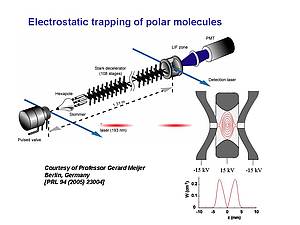
The EuroQUAM Programme will focus on four themes with linked objectives:
Atomic quantum gases with controllable interactions
Research on ultracold atomic matter has been an enormously productive field. Novel experiments on Bose-Einstein condensates and Fermi-degenerate gases have stimulated the development of fundamentally new theories. Important phenomena based on coherent matter waves have been demonstrated, several of them being observed for the first time. Cold atom systems are also attracting great interest from condensed matter physicists, because they provide simple models of important effects such as superfluidity, superconductivity, vortices, solitons etc.
The special properties provided by degenerate atomic gases (of both bosons and fermions) offer exciting new opportunities for both fundamental and applied research. While key techniques to prepare such degenerate gases and to manipulate their external degrees of freedom have been widely developed, the active control of interactions has become a central research topic to break new scientific ground.
The main objectives of this topic are:
- Developing novel methods to tune interatomic interactions with magnetic, electric and optical fields;
- Creation of dipolar quantum matter to facilitate studies on anisotropic interactions;
- Exploration and exploitation of phenomena associated with the strongly interacting regime, such as fermion superfluidity and BEC-BCS crossover;
- Realization, control, and understanding of quantum matter in disordered regimes and observation of novel phase transitions, such as Bose glass and Anderson localization;
- Understanding and controlling interactions in mixed-species systems for applications to two-component quantum matter (Bose-Bose, Bose-Fermi, and Fermi-Fermi systems).
Formation of molecules in ultracold atomic gases
The years since 2002 have seen enormous advances in methods for producing molecules in ultracold atomic gases. It is now possible to create a range of alkali metal dimers by photoassociation and by magnetic tuning through scattering resonances, and molecular BEC has been achieved for the special case of fermion dimers in very high vibrational states.
The main objectives of this topic are:
- To explore novel methods of molecule production, such as photoassociation schemes based on ultrashort laser pulses;
- To understand atom-molecule and molecule-molecule interactions;
- To create Bose-Einstein condensates of molecules in the rovibrational ground state:
- To create quantum-degenerate gases of polar molecules to explore strong dipole-dipole interactions and strongly anisotropic behaviour in electric fields;
- To extend ultracold molecule production beyond the formation of simple dimers (creation of trimers, tetramers etc.) and thus to open up new vistas to understand few-body systems;
- To explore atom-molecule dynamics in optical lattices connecting molecular to condensed-matter physics.
Cooling molecules
The methods for forming molecules in cold atomic gases are very powerful, but are limited to molecules formed from coolable atoms (mostly alkali metals). There is therefore an intense parallel effort to cool molecules directly from room temperature. Several methods are now available to cool and trap molecules at temperatures of 1 to 100 mK. These methods are already providing access to new regimes for studying atomic and molecular collisions, but the temperatures achieved so far are too high for condensation to form molecular quantum gases.
The main objectives of this topic are:
- To develop new sources of cold molecules into practical tools;
- To explore various cooling schemes laser cooling, evaporative cooling, sympathetic cooling, stochastic cooling, cavity mediated cooling and trap reloading schemes to increase the phase-space density of trapped ground-state molecules;
- To lower the temperature of trapped molecules from the millikelvin range (now accessible) to the microkelvin range where condensation is feasible;
- To understand ultracold atom-molecule and molecule-molecule reactions;
- To explore the effect of electric and magnetic fields on molecular interactions and reactions;
- To develop a controlled ultracold chemistry based on a complete control over the reactants;
- To develop the uses of cold molecules in applications to metrology and precision measurement.
Ultracold plasmas and Rydberg gases
Photoionization of ultracold atoms has made it possible to form ultracold ions and thence create the first ultracold plasmas. In such plasmas both the ions and the electrons have kinetic energies much lower than those in any conventional plasma. These low temperatures introduce new physical phenomena, including recombination of the plasma to form ultracold Rydberg atoms. Indeed there appears to be an intricate relationship between the formation of ultracold plasmas and the formation of ultracold Rydberg gases, with recombination occurring on a timescale of tens of microseconds. Such research, however, remains in its infancy
The main objectives of this topic are:
- To explore new methods for forming ultracold plasmas for example using synchrotron radiation rather than laser irradiation and particle (e.g., electron) impact;
- To form ultracold plasmas from a wider range of species (e.g. from new cold atomic species and cold molecules);
- To understand the dynamics and structure of ultracold plasmas and evolution of ultracold Rydberg gases to form ultracold plasmas;
- To develop the methodology to bring ultracold plasmas into the correlated regime where the Coulomb energy between the plasma species dominates their kinetic energy, leading to the crystallization of the system;
- To explore photoassociation in Rydberg molecules as a methodology for the formation of the so-called trilobite or butterfly states and macrodimers;
- To prepare ultracold Rydberg atoms and/or cold ions in the ultracold plasma within an optical lattice, providing opportunities for controlled effects such as quantum hopping on a Rydberg lattice.

